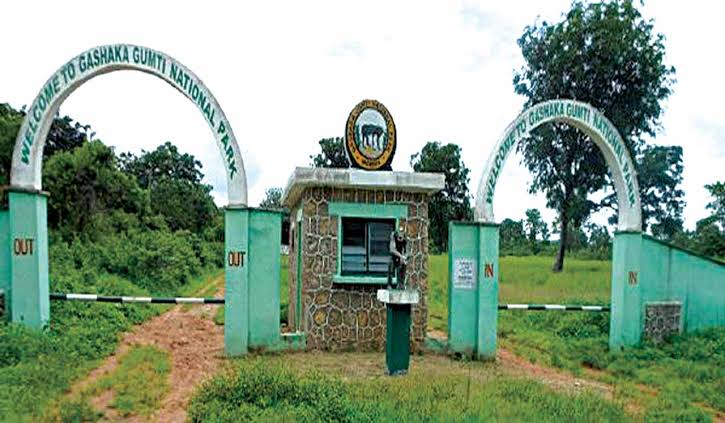Gashaka-Gumti National Park (GGNP) is a national park in Nigeria, It was gazetted from two game reserves in 1991 and is Nigeria’s largest national park. It is located in the eastern provinces of Taraba and Adamawa to the border with Cameroon.
The total area covers about 6,402 km2, much of the northern GGNP is savannah grassland, while the southern GGNP sector of the park has a rugged terrain characterized by very mountainous, steep slopes as well as deep valleys and gorges, and is home to montane forests.
Altitude ranges range from about 457 meters (1,499 ft) in the northern flatter corner of the k, to 2,419 meters (7,936 ft) at Chappal Waddi, Nigeria’s highest mountain in the park’s southern sections. It is an important water catchment area for the Benue River. There is abundant river flow even during the markedly dry season. Enclaves for local Fulani pastoralists exist within the park boundary that allow for farming and grazing.
The Gashaka Gumti region faced rampant hunting, putting immense pressure on its rich biodiversity. Recognizing the escalating threat, the Government of Northern Nigeria commissioned a land systems survey in 1966. This study, conducted by Mike Bawden and Paul Tuley, highlighted the urgent need to protect the watersheds of the forested mountains that supplied the River Taraba.
The Creation of Gashaka-Gumti National Park
In 1969, a wildlife expert from the Food and Agriculture Organization (FAO) of the United Nations recommended the creation of a game reserve or national park to safeguard local wildlife resources. These reports coincided with a period when Nigeria, having recently gained independence, prioritized the management of its natural resources, allocating significant financial resources to conservation programs.
In 1972, the Government of the North-East State collaborated with local governments and traditional chiefs of Ganye and Gashaka Gumti divisions to establish three-game sanctuaries—Serti, Gashaka, and Gumti. The ban on hunting within these sanctuaries marked a crucial step towards conservation.
As Nigeria’s economy faltered in the early 1980s, budgets for conservation initiatives, including Gashaka Gumti, were slashed. Neglect ensued, affecting infrastructure, patrolling, and overall park management. The park faced a catastrophe in 1983–84 with the outbreak of pan-African rinderpest, leading to the decimation of ungulates and a surge in poaching.
In the late 1980s, the Department for International Development (DFID) extended a lifeline to the park, injecting funds for critical projects. Simultaneously, the Nigerian Conservation Foundation (NCF) proposed to the Federal Government that Gashaka Gumti be designated a national park. Eleven main reasons were identified, ranging from the protection of watersheds to the development of ecotourism.
In 1991, Gashaka Gumti National Park was officially designated under new legislation. Managed by the NCF in partnership with the Gongola State Government’s Wildlife Unit, the project aimed to address various conservation challenges. Faith Ananze, an experienced manager, led the initiative, assembling a dedicated team of workers to embark on the revitalization of the park.
It is the sheer variety of different habitats within Gashaka-Gumti National Park that makes the area so uniquely rich in wildlife. The park is an intricate mosaic of montane grasslands, savannah woodlands, swamps, lakes, mighty rivers, dark lowland rainforests, and luxuriant, montane rainforests strewn with ferns and orchids. Each habitat supports its distinctive community of plants and animals.
Rainforests provide a haven for animals such as the Giant forest hog, leopard, Yellow-backed duiker, Golden cat, and many different primate species including chimpanzees. Woodland savannahs are home to buffalo, lions, elephants, and Wild dogs, as well as various antelopes such as waterbuck, Roan antelope, kob, hartebeest, and the world’s largest antelope, the Giant eland.
The mountains of the park harbor populations of the rare Adamawa mountain reedbuck, in addition to the Black-and-white colobus monkey, baboon, warthog, oribi, and klipspriItsst its largest unspoiled rivers contain hippos, crocodiles, otters, and a wide variety of fishes.
The park is officially labeled as one of Africa’s “Important Bird Areas” – and with more thalabeledecies found here, this is certainly no exaggeration. Visiting bird watchers constantly add new species to the list.
READ ALSO: Do The Tiv Truly Entertain Visitors With Their Wives?
An additional abundance of creatures such as butterflies, flowers, and trees, makes this park a naturalists’ paradise, unrivaled anywhere, for diversity.

